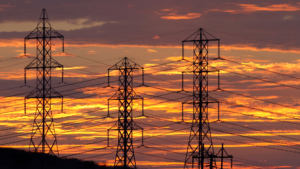 Electricity travels miles to power your home, through an intricate network of distribution and transmission power lines, which work together to ensure your home stays warm and bright throughout the year.
Electricity travels miles to power your home, through an intricate network of distribution and transmission power lines, which work together to ensure your home stays warm and bright throughout the year.
Transmission Power Lines
Transmission power lines carry electricity from power plants to municipal power grids. These lines can stretch for miles, sometimes across several states. For instance, New York’s transmission lines allow it to import electricity from Quebec. California imports power from Oregon and Utah.
Because transmission power lines connect directly to generating stations, they’re designed to carry incredibly high loads: 69 kV-765 kV (kilovolts). Transmission lines are noticeable for their high towers, which extend 150 feet above the ground, the same height as a 10-story building. To ensure their safety and reliability, vegetation around transmission lines is carefully controlled. Nothing above 15 feet is allowed to grow beneath them.
Other notable characteristics include:
- 3 Phase Alternating Current. To deliver power efficiently, transmission power lines use a three-phase system, which gives it a uniform frequency and allows it to transmit more power with less conductor material.
- Thick, Uninsulated Wires. Despite their high voltage, transmission lines are uninsulated. Due to their height, they’re effectively insulated by the air. Adding a layer of rubber would significantly increase their weight without providing any meaningful protection.
- Bi-Directional. Rather than flowing in a single direction, transmission lines can send electricity in either direction. This allows operators to respond to changes in demand, shifting power from one sector to another, to keep the grid balanced.
There are two types of transmission power lines. Primary lines connect plants to receiving stations, where the voltage is reduced below 35,000 volts. Then secondary lines send it to substations, where the voltage is reduced even further before it’s dispersed through the distribution grid.
Distribution Power Lines
Distribution lines carry electricity from substations to individual homes and businesses. Just as there are two types of transmission lines, there are also two types of distribution lines. Primary lines carry electricity from substations to distribution stations, which reduces the voltage again before secondary lines deliver it to your home.
Distribution lines are designed to convey power for only a short distance within a city. As a result, their capacity is much lower: 69 kV or less. Because of their low voltage, distribution line towers are much shorter, only 30 feet tall, the same as a two-story house. Though vegetation around distribution lines isn’t as tightly controlled, it’s recommended you leave ten feet of space between your trees and the lines powering your home.
In contrast to transmission power lines, distribution lines are:
- Single or Multi-Phase. Because of their low voltage, most distribution lines are single-phase. However, a three-phase system may be used to supply buildings with large energy requirements.
- Thin and Insulated. Because distribution lines are smaller and closer to the ground, most are covered with a layer of rubber insulation to prevent fires and other accidents.
- Mono Directional. Power flows only one way through distribution lines, from the substation to your home, never back again. If the network becomes overloaded, power is redistributed through the transmission grid, not the distribution grid.
Saving Energy With Agway
As a supplier, Agway utilizes both distribution and transmission power lines to deliver energy to your home. We also protect the electric lines within your home or business with our EnergyGuardTM program. Everyone is automatically enrolled when they become an Agway customer. There are no deductibles or service fees, just a network of skilled professionals ready to assist you 24/7. Click to sign up today!